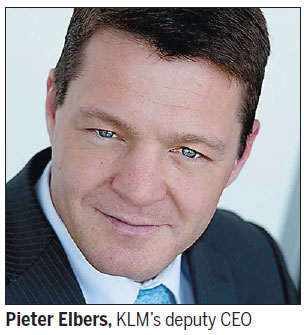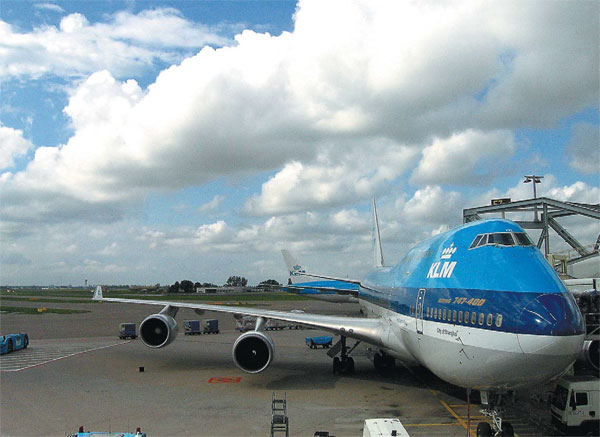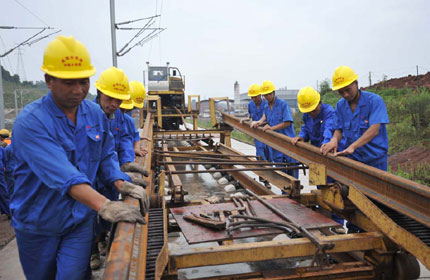In it for the long haul
Updated: 2014-07-04 08:11
By Martin Banks (China Daily Europe)
|
|||||||||||
|
KLM Royal Dutch Airlines is now considered the European leader in traffic between China and Europe. Provided to China Daily |
Together with its partner Air France, Dutch flag carrier operates 88 weekly flights between China and Paris-Charles de Gaulle and Amsterdam
Relations between China and the Netherlands have come a long way since the submarine supply dispute between the two governments in 1980, the result of an export license given by the Dutch government for submarine exports to Taiwan.
The resulting damage to trade relations between China and the Netherlands has now been well and truly repaired.
In fact you would be hard pressed to find a European airline enjoying more productive relations with Beijing than KLM Royal Dutch Airlines.
The Dutch carrier, which merged with Air France in 2004, is now considered the European leader in traffic between China and Europe.
Together with Air France, it operates 88 weekly flights between China and Paris-Charles de Gaulle and Amsterdam Airport Schiphol.
From Amsterdam there are 64 weekly flights to China (including Hong Kong and Taiwan), including a daily flight by its partner China Southern Airlines to Guangzhou.
Even if China remains a developing nation with GDP per capita below the global average, it is the world's second-largest market for passenger airline services, measured by total seat capacity.
While 78 percent of this capacity is domestic, China still ranks as the seventh largest international aviation market and the largest outside Europe, the United States and the United Arab Emirates.

In the last few years, Pieter Elbers, KLM's deputy CEO, has enjoyed regular dialogue with counterparts at China Southern, including Zhang Zifang, the Party Secretary of China Southern Airlines Company, during which views on the international aviation marketplace, joint operational performance and hub construction have been widely discussed.
Today Elbers oversees a passenger business with 6.6 billion euros of revenues, 25 million passengers a year, 160 aircraft, 650 flights a day to 131 international destinations and 20,000 staff.
His airline started flying to Beijing in 1996 and then, three years later, to Shanghai.
But since 2002, traffic between the two has mushroomed at an average of 10 to 15 per cent a year, from 140 weekly flights to 400.
Elbers says it is a "great source of pride" that KLM boasts eight non-stop destinations to China, including to Hong Kong and Taiwan.
While London (104), Frankfurt (80) and Paris (96) may have more weekly flights to China in total than Amsterdam, you can fly from there to more smaller Chinese destination cities.
This, Elbers says, "demonstrably proves" that geographically the "excellently placed" Amsterdam is now Europe's main gateway to China, with one million passengers now flying between the Dutch city and China annually.
Elbers adds that a correlation between China's rapid economic rise and its air traffic with Europe has "clearly materialized".
The secrets of his company's success in China are three-fold, he says: building its own network in the country; extending code share destinations (26 to date), and developing ties with Chinese airlines, in particular China Southern, the country's biggest domestic airline.
Code sharing cooperation offers companies like KLM, he says, the opportunity to offer customers more frequent flight options, while the operators themselves gain in terms of income and market share on operated routes.
The joint venture with China Southern also increases the visibility of Air France and KLM in the Chinese market.
After launching its Shanghai route, KLM launched flights, first, to Chengdu (now four a week), followed in 2010 to Hangzhou (now up to three weekly) and a year later to Xiamen (also three).
But another important factor is what he calls the "China fixation".
At Schiphol, this includes self-service machines in Chinese, Chinese-speaking ground personnel, Chinese newspapers in its business lounge, and even maps of the airport in Chinese.
On board, there are Chinese newspapers and magazines, Chinese cabin crew, menus in Chinese, typical Chinese food and drinks, and announcements in Mandarin and Cantonese. There is also inflight entertainment in Chinese and even Chinese crockery and tableware.
The Dutch-born Elbers, who has been with KLM for 22 years, recently took part in a week of briefings with China Southern to get a "better understanding" of how it works with airports and governments, and of its other operations, including its labor relations and human resources.
"It was an invaluable experience and insight, and is something I would like to develop more," he says.
Enhancing partnerships with other airlines is a key part of Elbers' plans.
The company's ever-closer links with China have provided a much-needed boost for the Dutch economy, given that 450 Chinese companies are now believed to have operations in the Netherlands, he says.
Exports to China from there have soared fivefold in the past decade to 7.8 billion euros last year, and China's investments in the Netherlands have risen tenfold since 2006, to more than 700 million euros last year.
However, he insists the picture "is not all rosy" and that "a lot of additional work" is still needed in terms of learning and understanding.
"While many airline executives like myself were still at school, China was still a closed society and, economically, it only started opening up in 1978.
"We have to remember that it is only in the last 15 to 20 years that this 'economic reopening' has fully blossomed so we have a lot of work to do when it comes to better understanding China.
"Europeans and Chinese have different backgrounds, but we are making a lot of effort, such as in the training program I attended, to bridge those differences."
One particular challenge for the future, he says, will be to match the profitability of less popular destinations in China with the rapid growth in the number of cities it now serves.
At present, 60 percent of KLM's passengers on the Beijing and Shanghai routes are from Europe, and the rest come the other way from China.
He says the airline's operations into the "big two", Beijing and Shanghai, enjoy a "stronger foundation" than traffic to the smaller, regional Chinese cities.
"Clearly, the volume is there, but we are working with tour operators to create more awareness in Europe of Chinese cities other than Beijing and Shanghai while, in China, we're running campaigns about the existence of our flights to Europe."
As well as pricing and heavy competition on Chinese routes, Elbers says the country's expansion has been so rapid that Chinese air space can often become very congested.
"But I have to say that China's efforts at dealing with this, with its improvements to airport infrastructure, are formidable and certainly well ahead of other BRIC countries like Brazil and India".
Despite the economic recession still being felt in Europe and elsewhere, he predicts annual growth of 8 to 10 percent in China, "something we want to be part of".
China is now KLM's second-largest market after the US outside Europe, and he believes the recent visits to Europe by China's leaders, and the signing of key trade agreements between the two sides, can only further strengthen the relationship.
Elbers readily admits to speaking only a "little Chinese", despite making about 60 visits to the country since 2005.
"As Europe continues to emerge from the economic crisis, we will see business connections between Europe and China continue to grow and become further enhanced," he says, with the use of social media growing as a key marketing tool.
As the company enjoys the benefits of a recent campaign promoting football World Cup packages in Chinese, Elbers boasts of strong staff exchanges, and would like to boost the number of fulltime Chinese nationals working in its Dutch operations.
The first appointment at its headoffice at Schipol was Chinese staff member Shanshan Li, who has been working to promote the company to Chinese firms.
"I would certainly like us to move this to another level, so we have not just one Shanshan here, but several."
For China Daily
(China Daily European Weekly 07/04/2014 page20)
Today's Top News
Gambling costs World Cup fans their lives
US supports Ukraine's decision to suspend ceasefire
It's all about making a spectacle
China likely to see 7.5% growth in second quarter
Palace Museum feeling the squeeze of visitors
Myanmar pagoda replica given to China
US sends 300 more troops to Iraq over concerns
Hong Kong at the crossroads
Hot Topics
Lunar probe , China growth forecasts, Emission rules get tougher, China seen through 'colored lens', International board,
Editor's Picks

|

|

|

|

|

|






